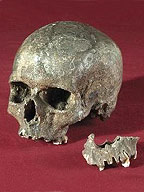
The historical sciences – geology, biology,
paleoanthropology – are continually adding new information to the ancient story
of humans on earth, thanks in part to new technology and methods.
Anthropologists have said that human beings evolved in a straight line from homo
habilis to homo erectus to us, homo sapiens.
But fossil bones found in 2000 near Lake Turkana in Kenya are changing that view
according to Fred Spoor (University College, London), paleontologist and lead
author of the study reported in the Smithsonian (October 2007).
The fossil/geological records show that both homo erectus and homo habilis
existed beginning 1.9 million years ago to at least until 1.44 million years
ago, some 450,000 years. They must have survived side by side and somehow found
niches so they would not directly compete – maybe focusing on different diets or
habitats, like chimpanzees and gorillas today.
“This research shows that we evolved in the same way other animals did in an
experimental unpredictable way, with side branches that die out after a long
time, and then something else comes along. That differs from the
human-concentric way of thinking in the classical cartoon of a chimpanzee
evolving into a person as if there was a hand steering chimpanzee-looking
creatures to modern man”.
It means that homo erectus and homo habilis are really sister species with a
common ancestor older than 2 million years, contrary to the linear view of
physical evolution. More and more evidence everyday is telling us that a
rewriting of our history is necessary and that maybe we shouldn’t hold so
strongly to old assumptions.